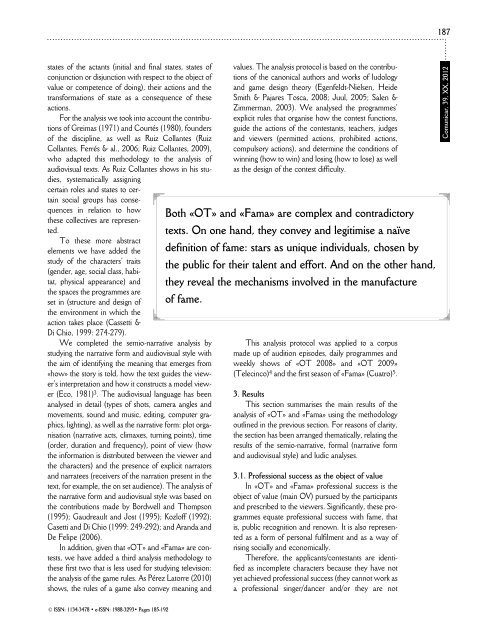Comunicar 39-ingles - Revista Comunicar
Comunicar 39-ingles - Revista Comunicar
Comunicar 39-ingles - Revista Comunicar
You also want an ePaper? Increase the reach of your titles
YUMPU automatically turns print PDFs into web optimized ePapers that Google loves.
187states of the actants (initial and final states, states ofconjunction or disjunction with respect to the object ofvalue or competence of doing), their actions and thetransformations of state as a consequence of theseactions.For the analysis we took into account the contributionsof Greimas (1971) and Courtés (1980), foundersof the discipline, as well as Ruiz Collantes (RuizCollantes, Ferrés & al., 2006; Ruiz Collantes, 2009),who adapted this methodology to the analysis ofaudiovisual texts. As Ruiz Collantes shows in his studies,systematically assigningcertain roles and states to certainsocial groups has consequencesin relation to howthese collectives are represented.To these more abstractelements we have added thestudy of the characters’ traits(gender, age, social class, habitat,physical appearance) andthe spaces the programmes areset in (structure and design ofthe environment in which theaction takes place (Cassetti &Di Chio, 1999: 274-279).We completed the semio-narrative analysis bystudying the narrative form and audiovisual style withthe aim of identifying the meaning that emerges from«how» the story is told, how the text guides the view -er’s interpretation and how it constructs a model view -er (Eco, 1981) 3 . The audiovisual language has beenanalysed in detail (types of shots, camera angles andmovements, sound and music, editing, computer gra -phics, lighting), as well as the narrative form: plot organisation(narrative acts, climaxes, turning points), time(order, duration and frequency), point of view (howthe information is distributed between the viewer andthe characters) and the presence of explicit narratorsand narratees (receivers of the narration present in thetext, for example, the on set audience). The analysis ofthe narrative form and audiovisual style was based onthe contributions made by Bordwell and Thompson(1995); Gaudreault and Jost (1995); Kozloff (1992);Casetti and Di Chio (1999: 249-292); and Aranda andDe Felipe (2006).In addition, given that «OT» and «Fama» are contests,we have added a third analysis methodology tothese first two that is less used for studying television:the analysis of the game rules. As Pérez Latorre (2010)shows, the rules of a game also convey meaning andvalues. The analysis protocol is based on the contributionsof the canonical authors and works of ludologyand game design theory (Egenfeldt-Nielsen, HeideSmith & Pajares Tosca, 2008; Juul, 2005; Salen &Zimmerman, 2003). We analysed the programmes’explicit rules that organise how the contest functions,guide the actions of the contestants, teachers, judgesand viewers (permitted actions, prohibited actions,compulsory actions), and determine the conditions ofwinning (how to win) and losing (how to lose) as wellas the design of the contest difficulty.Both «OT» and «Fama» are complex and contradictorytexts. On one hand, they convey and legitimise a naïvedefinition of fame: stars as unique individuals, chosen bythe public for their talent and effort. And on the other hand,they reveal the mechanisms involved in the manufactureof fame.This analysis protocol was applied to a corpusmade up of audition episodes, daily programmes andweekly shows of «OT 2008» and «OT 2009»(Telecinco) 4 and the first season of «Fama» (Cuatro) 5 .3. ResultsThis section summarises the main results of theanalysis of «OT» and «Fama» using the methodologyoutlined in the previous section. For reasons of clarity,the section has been arranged thematically, relating theresults of the semio-narrative, formal (narrative formand audiovisual style) and ludic analyses.3.1. Professional success as the object of valueIn «OT» and «Fama» professional success is theobject of value (main OV) pursued by the participantsand prescribed to the viewers. Significantly, these programmesequate professional success with fame, thatis, public recognition and renown. It is also representedas a form of personal fulfilment and as a way ofrising socially and economically.Therefore, the applicants/contestants are identifiedas incomplete characters because they have notyet achieved professional success (they cannot work asa professional singer/dancer and/or they are not<strong>Comunicar</strong>, <strong>39</strong>, XX, 2012© ISSN: 1134-3478 • e-ISSN: 1988-3293• Pages 185-192
















